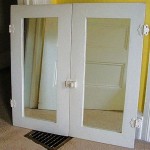How to Use Mirrors to Create More Light
Mirrors offer a simple yet effective way to enhance the natural light within a space. Strategically placed mirrors can transform a dim room into a bright and welcoming area, reducing the need for artificial lighting and contributing to energy savings. Understanding the principles of reflection and applying a few practical tips can maximize the impact of mirrors in any environment.
Understanding Light Reflection
Light travels in straight lines until it encounters a surface. When light strikes a mirror, it is reflected back at an angle equal to the angle of incidence. This principle is key to understanding how mirrors can be used to redirect and amplify natural light.
Key Considerations for Mirror Placement
Placement is crucial for maximizing the effectiveness of mirrors in brightening a room. Consider the following:
- Opposite Light Sources: Placing a mirror directly opposite a window or other natural light source is the most effective way to amplify the incoming light. The mirror reflects the light back into the room, creating a brighter, more open feel.
- Adjacent to Light Sources: Positioning a mirror adjacent to a window can also increase light, although not as dramatically as placing it directly opposite. This technique can be useful in rooms with limited wall space or where a direct reflection might be too intense.
- Angling for Reflection: Carefully angling a mirror can direct light towards specific areas of a room that might otherwise be shadowed. Experiment with different angles to achieve the desired effect.
Maximizing Natural Light with Mirrors
Several strategies can be employed to optimize the use of mirrors for natural light enhancement:
- Large Mirrors for Maximum Impact: Larger mirrors reflect more light than smaller ones. Consider using oversized mirrors or groupings of smaller mirrors to create a significant impact.
- Mirror Shape and Style: While the shape and style of the mirror can be chosen based on aesthetic preferences, certain shapes can enhance light reflection. For example, convex mirrors can reflect light in a wider arc, brightening a larger area.
- Cleanliness is Key: Dust and dirt can significantly reduce a mirror's reflectivity. Regular cleaning ensures optimal light reflection.
Using Mirrors in Specific Rooms
Different rooms benefit from specific mirror placement strategies:
- Living Rooms: Placing a large mirror above a fireplace or on a wall opposite a window can significantly brighten a living room.
- Bedrooms: Mirrors can brighten bedrooms, but avoid placing them directly opposite the bed, as this can sometimes be disruptive to sleep.
- Hallways and Entryways: These often dimly lit areas can benefit greatly from strategically placed mirrors to reflect light from adjacent rooms.
- Bathrooms: Mirrors are essential in bathrooms, but consider supplementing the standard vanity mirror with additional mirrors to maximize natural light.
Enhancing Artificial Light with Mirrors
Mirrors can also be used to amplify the effects of artificial lighting:
- Reflecting Lamplight: Placing mirrors near lamps or other light fixtures can help distribute the light more evenly throughout a room.
- Creating the Illusion of More Space: Strategically placed mirrors can reflect artificial light, making a room appear larger and more open.
Mirror Placement Mistakes to Avoid
While mirrors can be incredibly effective in brightening a space, certain placement choices should be avoided:
- Reflecting Clutter: Avoid placing mirrors where they will reflect clutter or unattractive views. This can create a sense of disorganization and detract from the overall aesthetic.
- Creating Glare: Be mindful of the angle of reflection to avoid creating glare, which can be uncomfortable and distracting.
- Overusing Mirrors: While mirrors are beneficial, overusing them can create a disorienting and cluttered feel. Strive for a balance that enhances the space without overwhelming it.
Combining Mirrors with Other Design Elements
Mirrors can be seamlessly integrated with other design elements to create a cohesive and light-filled space:
- Pairing with Light-Colored Walls: Light-colored walls reflect light more effectively than dark walls, and combining them with mirrors further amplifies the brightening effect.
- Using Metallic Frames: Metallic mirror frames can add an extra element of reflectivity, further enhancing the light in a room.
- Incorporating Plants: Placing plants near mirrors can create a vibrant and refreshing atmosphere while also benefiting from the increased light.
Choosing the Right Mirrors
The type of mirror selected can impact the overall effect:
- Frameless Mirrors: Frameless mirrors offer a sleek and modern look and can create a sense of spaciousness.
- Decorative Mirrors: Mirrors with ornate frames can serve as both decorative elements and light reflectors.
- Antique Mirrors: Antique mirrors add character and a vintage touch, while still providing light reflection.
By understanding the principles of light reflection and employing these strategic placement techniques, one can effectively utilize mirrors to create brighter, more inviting spaces.

6 Ways To Use Mirrors Make Your Home Feel Bigger And Brighter

How To Use Mirrors For More Light And Style

6 Ways To Use Mirrors Make Your Home Feel Bigger And Brighter

Five Ways To Use Mirrors Add Light And Space Nm Design

How To Use Mirrors Brighten A Room Murray Glass

How To Use Mirrors For More Light And Style
12 Ways To Use Mirrors Create More Space Kolo

How To Use Mirrors In Your Home Enhance Natural Light Libra Interiors

New Ways To Bring Light Into Your Home Using Glass Mirrors

Decorating With Mirrors 15 Creative Ways To Reflect Light And Space Arch2o Com








